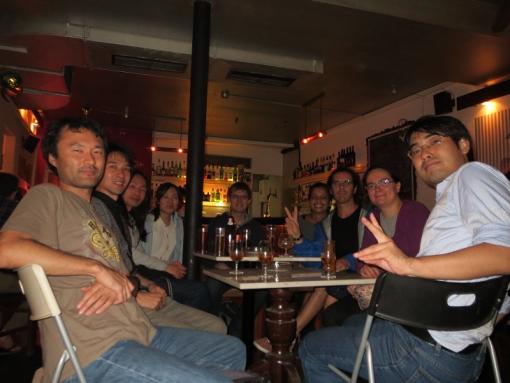Richard wins a scholarship for young researchers from Gulbenkian
Friday, November 29, 2013Richard Brito won a scholarship from the Programa de Estímulo à Investigação Científica (Scientific Stimulus Research Program), organized by the Calouste Gulbenkian Foundation. Brito’s project, supervised by researchers Vitor Cardoso and Paolo Pani, is titled “Pesando os Mensageiros de Einstein” (”Weighing Einstein’s Messengers”, in English) and identifies gravitons as “Einstein’s messengers”. The project intends to study the consequences that massive gravitons may have for general relativity.
Every year the Scientific Stimulus Research Program rewards young researchers with less than 26 years in the areas of Mathematics, Physics, Chemistry and Earth and Space Sciences. You can find more information (in Portuguese) about the Scientific Stimulus Research Program, and this year winners, here.
Highlights of CQG
Monday, November 25, 2013The article Tidal acceleration of black holes and superradiance by Cardoso and Pani was selected by the Editorial Board of Classical and Quantum Gravity (CQG) to be one of the journal’s Highlights of 2012-2013.
The Highlights will be promoted as a representation of some of the most interesting and high quality work in gravitational physics.
Workshop on collapsing objects
Saturday, October 26, 2013
Vitor was one of the plenary speakers at the workshop on collapsing objects, held in Shanghai. You can see the programme and talks here
Dirty black holes are more interesting!
Sunday, October 6, 2013One of the most awe-inspiring properties of black holes is their absolute simplicity, or as John Wheeler famously put it, “black holes have no hair”. As their progenitor collapses, its memory is forever lost, and all that remains is a quiescient, almost featureless, black hole. In a new article to appear in Physical Review Letters, our group questions whether this conclusion applies to realistic, astrophysical black holes.
Isolated, “clean” black holes are almost xeroxed copies of one another, differing at most in mass and rotation. These objects are described by a solution discovered by Roy Kerr in 1963. Remarkably, Kerr black holes are ubiquitous in almost any other theory of gravity, to the extend that the “Kerr hypothesis” is the current paradigm in astrophysics.
We have shown that in simple, well-motivated extensions of Einstein’s theory known as scalar-tensor theories, black holes may not be described by the Kerr metric, as was previously thought. The crucial ingredient is the matter surrounding astrophysical black holes, typically in the form of accretion disks. The presence of matter in such “dirty” black holes forces the hairless Kerr black hole to develop a new charge — new “hair” — anchoring it to the surrounding matter and possibly to the entire galaxy”.
This hair growth is accompanied by a peculiar emission of gravitational waves, potentially detectable by upcoming laser interferometers, which may test the Kerr hypothesis and probe the very foundations of gravity.
See the media blurb on our article, in New Scientist, Huffington Post, and Público .
Shijun Yoshida visits our group
Saturday, October 5, 2013 Prof. Shijun Yoshida from Tohoku University visited our group in IST. Shijun was a postdoc in IST some years ago, where he did interesting and important work on linearized fields in black hole spacetimes (quasinormal modes, tails, black hole bombs). This picture was taken in Bairro Alto, in Cafe Suave.
Prof. Shijun Yoshida from Tohoku University visited our group in IST. Shijun was a postdoc in IST some years ago, where he did interesting and important work on linearized fields in black hole spacetimes (quasinormal modes, tails, black hole bombs). This picture was taken in Bairro Alto, in Cafe Suave.